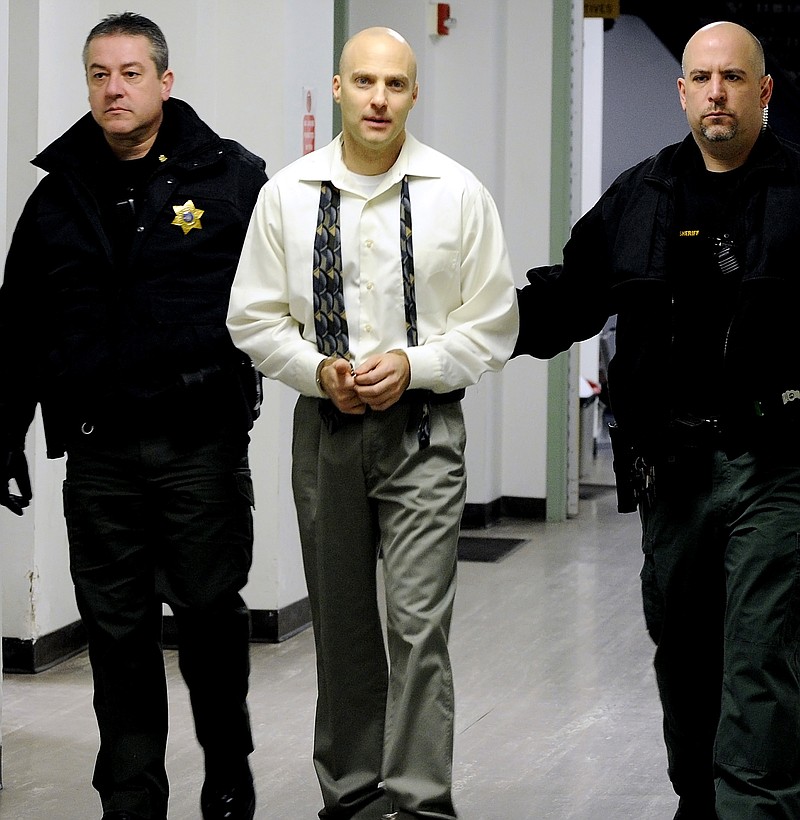WILKES-BARRE, Pa. -- A notorious career criminal brutally beat and strangled a pharmacist and the pharmacist's girlfriend as part of a plot to steal tens of thousands of dollars from the druggist, who had been operating a prescription drug ring and was flush with cash, a prosecutor said Wednesday.
Hugo Selenski needed about $10,000 to cover a check his girlfriend had written to purchase a house. He got that and far more, Luzerne County Assistant District Attorney Jarrett Ferentino told jurors in an opening statement that portrayed Selenski as greedy, manipulative and violent.
The trial opened nearly a dozen years after investigators found at least five sets of human remains buried in Selenski's yard. He is charged with strangling two of the victims: Michael Kerkowski, a pharmacist who had called Selenski his best friend, and Kerkowski's girlfriend, Tammy Lynn Fassett, who prosecutors say was in the wrong place at the wrong time when they say Selenski and a co-conspirator showed up at Kerkowski's house in May 2002.
Selenski, 41, has pleaded not guilty to homicide, robbery and related counts. Prosecutors are seeking the death penalty.
Selenski operated in "a world of manipulation, a world of violence. You will hear it's a world of greed. You will hear it's a world that leaves its victims bound and broken," Ferentino said. "What you hear will shock you. It will horrify you. And it will break your heart. But it happened."
Selenski and co-conspirator Paul Weakley bound the victims and covered their eyes with duct tape, Ferentino told the jury. Kerkowski was beaten with a rolling pin, and he and Fassett were strangled with flex ties.
While he was being tortured, Kerkowski revealed the location of tens of thousands of dollars he'd hidden in the house, Ferentino said. After the killings, Selenski stole tens of thousands more that Kerkowski had given to his father for safekeeping -- at one point pointing a gun at the father and threatening him, the prosecutor said.
Selenski blew through $100,000 of the pharmacist's money in three months, Ferentino said.
Selenski, who is already serving a decades-long prison sentence in a home invasion and robbery, grimaced, shook his head and whispered to his attorneys throughout the prosecutor's presentation.
His attorney, Bernard Brown, pinned all the blame on Weakley, who avoided a death sentence by pleading guilty to federal charges in connection with the killings and is scheduled to testify against Selenski in hopes of winning a reduction to his life sentence.
Brown told jurors that Weakley's story to police shifted over time, and he contended the evidence points to Weakley as the sole culprit.
Weakley led police to Selenski's property north of Wilkes-Barre in June 2003. There, they found the corpses of Kerkowski and Fassett in a shallow grave, with plastic ties around their necks.
Weakley knew the location of the bodies, Brown said Wednesday "because he put them there."
State police Lt. Richard L. Krawetz, the trial's first witness, testified that when police showed up at the property, Selenski laughed.
"This is ridiculous," he told Krawetz, according to the lieutenant's testimony. "There's no bodies here. I'll even help you dig."
But Selenski grew increasingly nervous, Krawetz said.
"He constantly gazed up toward the right rear corner of the residence," where investigators eventually found the two bodies, Krawetz said.
Police searched the rest of the yard and discovered additional human remains. Authorities have long said they found at least five sets of remains, but only four victims have ever been identified.
Prosecutors took an initial crack at Selenski in 2006, when he stood trial in the slayings of the other two victims who were identified. Prosecutors contended Selenski shot the men, both suspected drug dealers, then burned the remains. After a jury acquitted Selenski of one homicide and deadlocked on another, prosecutors immediately charged him in the deaths of Kerkowski and Fassett.
Kerkowski had pleaded guilty to selling more than 330,000 doses of painkillers without prescriptions and was awaiting sentencing when he and Fassett disappeared.
Shortly before the slayings, Selenski offered $20,000 to a would-be hit man to "take care" of Kerkowski, the man testified Wednesday.
Rodney Samson testified that he was drinking beer and smoking crack cocaine with Selenski when Selenski made the offer. Samson said Selenski knew he was behind in his child support payments.
"I said, 'I'll think about it,' Samson said. "It's a lot of money and I needed it."
Ultimately, Samson decided against killing Kerkowski. But he didn't immediately go to law enforcement, either.
Within weeks, the pharmacist and his girlfriend were dead.
